 The Mulch - Autumn 2009 The Mulch - Autumn 2009
Five Hens A-Laying…
Sue Stileman, a local Shiatsu practitioner, and husband Mark, share their experiences keeping five characterful hens in their Wellow garden…
“We got our five sixteen-week old hens in February this year. We chose cross-breed varieties for their reliable egg laying and hardiness and have hybrids of Cuckoo Maran, Light Sussex, Cream Crested Legbar (blue eggs), Blue Belle and Rhode Island.
“Our front garden is a story of two halves: one veg patch, the other chicken patch. We fenced an area of approx 25 square metres with galvanised wire (fox-proof, about six-foot tall) stretched between six eight-foot wooden posts dug into the ground and the base lined with wooden boards. We made a gate for access and customised a garden shed (6’x4’) with a small front door on hinges (about 1’x1’) so the main door can be shut and bad weather kept out, four nesting boxes (18” square) and two hazel perches (2” and rounded to keep feet healthy).
“The shed bedding is currently shavings but I am looking for an alternative that will decompose in the compost, and the run surface is wood chips which the girls enjoy scratching in. A few plants survived in their run (notably bamboo, choisya, bay and rosemary), providing shade, shelter and places for dust baths but otherwise they stripped it bare in a few days.
“I am a healer by trade and we avoid additives and artificial chemicals, so the girls are fed on organic layers’ pellets from a galvanised feeder and have a few hours free range in the garden every afternoon. Apple cider vinegar added to their water helps maintain healthy gut function and prevent parasites.
“Our five girls are all blooming and the eggs they bless us with every day are beautiful: extra large, fluffy whites and rich golden yolks which turn cakes and pastries deep yellow. They are simply the best eggs we’ve ever eaten and finding them in the nest boxes is a never-ending source of delight for all of us. We sell them at our gate (£1.50 per half-dozen) which pays for the next sack of feed.
“Would we encourage you to keep chickens at home? YES! Absolutely! The whole experience is fantastic. Your children will adore them, your friends and family will love the eggs and your “girls” will take over your hearts as well as your garden. Our next project in the garden is bees….”
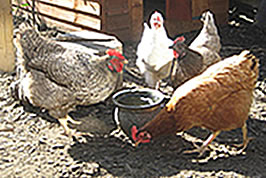 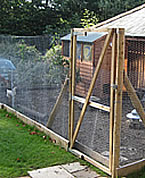
Beware! Space Invaders…
Over the years, I have learnt the hard way to be wary of certain plants that may beguile and charm on the packet or in the garden centre but that can end up quickly swamping a carefully designed border.
Of course, one person’s plant-from-hell is another person’s low maintenance carpeter, but there are some plants that really will grow ‘legs’, spread about or run amok in next to no time. Here’s my ‘top ten’ of space invaders that will make themselves too much at home in the average garden. Handle with care…
Small but perfectly formed…
It’s generally assumed that smaller gardens require less input from a designer as there’s less to see and less to rectify or improve. This isn’t necessarily so. Smaller gardens, in my opinion, can require much more design consideration than larger gardens as every square metre has to ‘earn its keep’.
Smaller spaces can be particularly rewarding to work with. You have to become intimately aware of every aspect and quality of the space as it comes under such intense scrutiny. I recently created a new gallery of very small gardens on the website, all under 25 sq.m. in area.
Here I talk about the design challenges, the clients’ brief and the design solutions that unfolded.
www.thegrowingcompany.co.uk/5x5_series.html
Elegant Elaeagnus
Elaeagnus x ebbingei, the false olive or Oleaster, enjoys a well deserved reputation as a tough, reliable, attractive and quick-growing evergreen hedge.
The leaves of Elaeagnus x ebbingei are silvery-grey on the underside and dark green on the upper side. It’s unusual in that it flowers in the autumn and fruits in the spring. The flowers are small, a whitish-cream colour and heavily scented. The fruits are olive-shaped and ripen to a dark red with silvery speckles (see picture below).
I used this species for a boundary hedge in a garden in Bassett three years ago. From about 90cm high on planting, the hedge is now more than 2.4m high in places (and that’s on fairly poor soil).
The fruit of another Elaeagnus, the Autumn Olive (Elaeagnus umbellatus), is considered to be highly nutritious. There are several recipes available for jam and wine made from the Autumn Olive and, according to ‘Plants for a Future’ (PFAF), Elaeagnus is currently being studied for potential beneficial effects in halting the progression of some cancers. The fruits are packed with bio-flavonoids, vitamins A, C and E and other bio-active compounds, making it a ‘superfruit’.
Elaeagnus also fixes nitrogen in the soil for the benefit of nearby plants and makes an ideal planting companion for orchard trees because of their insect-attracting capabilities. An all-round elegant solution for any garden!
Stuck for an evergreen hedge? Give Elaeagnus a go!
www.pfaf.org/leaflets/elaeagns.php
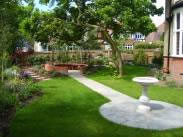 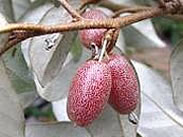
^A Bassett Garden
The 90cm high Elaeagnus x ebbingei hedge along the far boundary was planted in December 2006 (left picture). Three years later, it has grown to more than 2m tall (right hand picture).
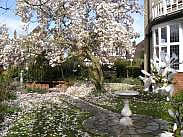 < Jolly Oleaster < Jolly Oleaster
Elaeagnus x ebbingei produces fruit in the spring. Other types of Elaeagnus are packed full of anti-oxidants, bio-flavonoids and vitamins – does anyone know if Elaeagnus x ebbingei is edible?
Tidy by Nature
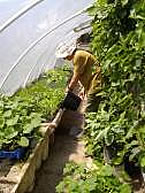 I recently visited Broughton Organics, run by veteran perma-culturist, Tid Tidy, after he gave a passionate and fascinating illustrated talk to my local garden designer group. I recently visited Broughton Organics, run by veteran perma-culturist, Tid Tidy, after he gave a passionate and fascinating illustrated talk to my local garden designer group.
Tid has been cultivating his 3 acre smallholding under the Broughton Downs for 30 years. Tid’s shop, selling his home-grown produce, is on the Salisbury Road out of Broughton.
www.foodfirst.co.uk/pro07670.htm
Cuttings…
That’s My Boy!
Plant scientists believe they have discovered a mechanism that enables plants to recognise their genetic kin, and then to act in a protective way towards them. The experiment with a Sagebrush plant (Artemisia tridentata) suggested that it ‘communicated’ with a cutting of itself planted nearby and co-operated to avoid being eaten by herbivores. (Source BBC / Ecology Letters, June 09)
I Say Tomato, You Say Asbo
A grandmother from Neath has been issued with an Asbo warning after growing tomato plants in the entrance foyer of her block of flats. (Source: BBC July 09)
Damsels in Distress
The British Dragonfly Society (BDS) report a sharp decline in dragonfly and damselfly numbers. Since the 1950s, three species have become extinct and a third of the remaining 42 species found in Britain are also under threat.
Loss of wetland, intensive agriculture and housing development are likely to have contributed to the decline.
www.dragonflysoc.org.uk/dragonfliesinfocus.html
Once Upon A Time…
I’ve been a volunteer for the Hampshire Gardens Trust for more than 10 years. Back in the summer Jan Hurrell, editor of the in-house magazine, popped by to chat about my background, my work and current projects. The interview, which is in the Autumn 2009 edition of the Hampshire Gardens Trust magazine, was an interesting experience – Jan’s interviewing style drew out many memories and insights that I hadn’t really put together into a coherent narrative before! www.hgt.org.uk
Autumn Transplanting
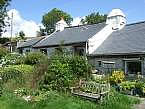 This winter, I shall be completing my relocation to North Wales. We recently purchased an old stone cottage to renovate with a wonderful sloping garden, about 600ft up a mountain. I’ll be reporting on progress via the website. This winter, I shall be completing my relocation to North Wales. We recently purchased an old stone cottage to renovate with a wonderful sloping garden, about 600ft up a mountain. I’ll be reporting on progress via the website.
_______________________________________________________________
What’s New on the Website …
I have updated lots of pages on the website and selected new pics of recent garden projects for the Galleries and the Befores ‘n Afters section. There’s also a new ‘5x5’ portfolio of small gardens under 25 sq.m. in area, along with commentaries on the design challenges and solutions.
With warmest wishes this festive season – and may 2010 be filled with many wonderful opportunities to grow well with your garden!
Mark Rendell
garden designer
____________________________________________________________
Imaginative and affordable design
and planting schemes for every kind of garden
www.thegrowingcompany.co.uk
m: 07780 920653
|

